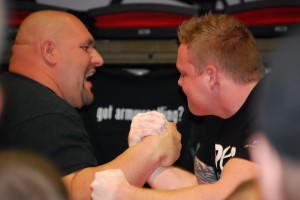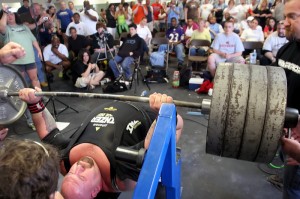Shawn Lattimer, one of the strongest SHW powerlifters until the late 2000s, made a major change in his sports career: he became an Arm Wrestler. A few years later, he was already at the top positions of the American AW national ranking. A successful engineer, Shawn talks about the different demands of each sport and his experience migrating from one to the other. This interview was given to me in January 2011.
- You have interrupted your career in powerlifting and migrated to arm wrestling. What would you say were your greatest accomplishments and richest learning in powerlifting?
My greatest accomplishment in Powerlifting is actually a tie. In 2003 I won my first pro competition in the WPO with an 810 lb. bench press, which was 2nd in the world at the time. It was also a personal best for me. My in meet record prior to that was 700, and my gym best was 765.
That is a tie in my mind with my all-time best lift of 905 lbs. in 2007.
I believe I was the 5th man in the world to bench 800 lbs. or more, and I was the 5th or 6th man to bench 900 lbs. or more.
My richest learning form powerlifting is patience. I may still hold the record for missing 900 lb bench attempts in competition. I believe I missed with 900 or more about 17 times in competition before finally achieving the 905 lift.
- How have you decided to become an arm wrestler? Did you have experience with this sport before?
I essentially became bored with powerlifting. I competed for 12 years, and I worked my way from a 460 lb. bench in my first meet all the way to 905. I toyed with the idea of chasing the 1000 lb. mark, but after the road to 900, I simply saw no allure.
A co-worked of mine is a well-respected armwrestler. She won the world championship title in 2005 right handed. We were discussing training one day over lunch, and I mentioned my need to find a new challenge. She suggested armwrestling, and gave me contact information for a team that trains near me. I decided to take her up on it and contacted Team New Jersey. From there forward, I became and arm wrestling addict.
Prior to this, my only armwrestling experience was at the lunch room table in high school, and a single armwrestling competition I foolishly entered having no knowledge of the sport (circa 1999). Needless to say, I hurt for a long time after that competition.
- Did you feel right away that you were naturally gifted for AW? Could you comment on the following factors that may or may not have influenced your success in AW: a. motor skills acquired from multiple sports; b. skill learning speed; c. background in powerlifting; d. being an engineer; e. being naturally strong; f. any other factor that you may think of
Gifted—–yes and no. I am gifted in the fact that I have a huge hand and incredibly strong fingers. I also had very strong wrists without ever really training them specifically. However, I found quickly that being strong as a powerlifter means absolutely nothing on an armwrestling table.
Armwrestling is a very counter-intuitive sport. Everything that you think should work, is exactly incorrect. Everywhere I was strong, had nothing to do with armwrestling. Everywhere I was weak, I needed to be strong. I spent 3 months being beaten by a 16 year old team member. The 154 pound lightweight was too strong for me to practice with…….
In particular, the bicep is incredibly important in armwrestling. I effectively ignored my biceps for years, as they are not of high importance in powerlifting. It took me a full year to get my bicep power up to acceptable levels for armwrestling.
Additionally, armwrestling requires power in the form of a static contraction. You want to lock your arm in position and move with your body. Powerlifting is a dynamic contraction, there the joints are in motion. The two types of strength are not on the same plane. I had to completely re-learn my motor skills and my methods of apply power.
An interesting positive factor: Armwrestling is highly dependent on tendon strength. Holding static contractions places a lot of strain on tendons. Tendons grow, recover, heal, etc. in the same way as muscles, but at a tiny fraction of the speed. I was lucky enough that the severe overloading I put my body through prepared my body relatively well for armwrestling. It took me about 6 months to get over the constant deep “toothache” type pain in my tendons. Many other novice armwrestlers require 1-2 years.
The last advantage I have had is my natural tendency to invest my brain fully into anything I attempt. I spent years understanding and fine tuning my bench technique by analyzing all of the tiniest portions of the motion and the attributes of powerlifting gear. I am doing the same thing with armwrestling. In this way I have found I am able to better play to my strengths and protect my weaknesses from my opponents. Essentially, the same mindset that makes me a good engineer does help me in sports as well.
- Do you feel your background in powerlifting helped your evolution in AW ? Why? (or why not)
My background has helped in some ways. As I mentioned before, patience is a huge factor. Additionally, I learned long ago that I have weaknesses. I learned how to identify, attack and eliminate weaknesses. This knowledge has very direct applications in armwrestling. Many competitors refuse to acknowledge weaknesses, and other acknowledge them but lack the insight to eliminate them. I’ve been lucky enough over the years to learn how to address my own weaknesses.
- Is any part of your training routine from powerlifting retained for AW or has it changed completely? What has been retained, if any?
I actually retain a lot of my training, but not specifically because its best for armwrestling. In large part, habit plays a big role. I have eliminated a few things, like heavy bench lockouts, bench shirt work, board presses, etc. I have modified some of my routines, like shoulders, to use single arm movements to activate additional core and stabilizing muscles. I stopped squatting and deadlifting several years ago due to lower back injuries, but otherwise I still do a streamlined version of the workouts I have always done. I have added a lot of armwrestling specific work for biceps, wrists, grip, rotation, etc. Recently I even started working on doing pullups.
- Briefly, how is your AW training and competition preparation? How do you build your periodization in AW?
Actually, I don’t periodize my training. Most of my armwrestling specific weight work is high repetition with heavy weight, aiming for 12-15 reps for endurance. I tend to work towards fatigue more so than any specific weight/rep/set goal. For the most part, I would say 30% of my strength is built with weights; the remainder is built during practice sessions on the armwrestling table with team mates.
Week to week the training is basically the same. The week leading into a tournament I suspend my training.
- Training frequency and intensity: is it the same, similar or different from PL? Some training systems employ 90-100% efforts every week, year round. How does that apply to AW? How many meets do you think a top AW may manage during one year?
The training is the same, but different at the same time, The level of intensity is the same, and the effort placed into the training is always 90-110% for table work. Work with the weights may vary significantly. However, less of the body is negatively affected by armwrestling, such that recovery times are a bit faster. Generally, table work goes to failure due to fatigue.
Different armwrestlers do a varingy number of tournaments per year. I average about 10 per year.
- CNS overtraining: does it occur in AW?
I really don’t feel that CNS overtraining occurs with any regularity. Generally, you are not placing the body into an overload condition. The bigger issue is fatigue. Overtraining in armwrestling tends to lead to tendonitis more so than anything else.
- How frequently (weekly, monthly) do you think you must train under a competitive setting (competition table, either with opponent or cables)?
I prefer to do table work once per week. My team holds a practice session every
Sunday for about 3 hours. We drill technique and work on strength and endurance. I feel that the table work is the most critical item in armwrestling.
- What kinetic chains and/or muscles are most recruited in AW and how do you feel an experienced powerlifter adjusts to eventual changes in that respect?
The majority of the upper body is involved in armwrestling. The forearms, biceps, and shoulders are the major players, with lesser involvement from the lats, erctors, abs, triceps, pecs, etc. The adaptation isn’t all that difficult, but finding so many neglected areas can be a bit depressing. I was amazed at how weak I was in specific areas, when I had felt that I was generally all-around strong.
- Do you believe it is possible to keep “double-sports-identity”, training and competing both PL and AW? If not, what lift would be most affected by the incorporation of AW?
It can be done. There are a few competitors who participate in both sports. I believe it is very difficult to rise to the top of both sports at the same time, but a truly superior athlete could do it.
I think the bench press would be most affected. At least in the gym, the soreness I get from armwrestling significantly limits my ability to train the bench.
- Last but not least, how are you enjoying AW? If you would like to say something about the sports environment, subjective feeling, etc., go ahead.
I absolutely love the sport. It has the same camaraderie and “brotherhood” that powerlifting has. The head to head nature of the competition is more fun for me; and the rush of competing is truly addicting. The fact that the sport is a chess game at its heart has a special attraction for me. I have to be ready with an attack, a defense, a counter attack, and a second defense…..in less than 30 seconds. And I have to prepare myself based solely on my previous knowledge of the opponent and reading his setup and grip at the table.
I’m having a great time, and I’ve been relatively successful in the 2 years I have been in the sport.


